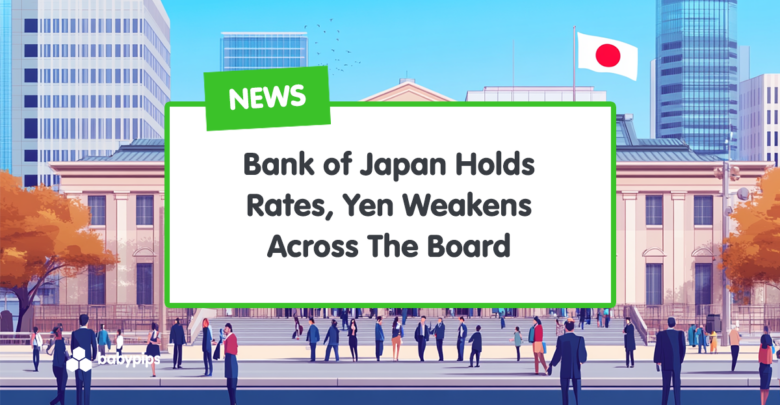The Bank of Japan (BoJ) kept its benchmark interest rate unchanged at 0.5% today, triggering a significant weakening of the Japanese yen across major currency pairs. The decision reflects the central bank’s cautious stance amid ongoing global trade uncertainties and domestic economic headwinds.
Key Takeaways:
- Maintained its benchmark rate at 0.5%, as widely expected
- Revised growth forecasts downward, citing global trade war concerns
- Pushed back the timeline for achieving its 2% inflation target to fiscal 2027
- Emphasized commitment to accommodative financial conditions
- Acknowledged risks from U.S. tariffs and potential global economic slowdown
In his press conference, BoJ Governor Kazuo Ueda struck a decidedly dovish tone, highlighting that while the Japanese economy is expected to grow above its potential rate, significant external risks remain. “The Bank will continue to support the economy by maintaining accommodative financial conditions,” Ueda stated, while acknowledging the adverse effects of prolonged easing, such as yen depreciation.
Regarding inflation, the central bank now projects core CPI for FY25 at 2.4%, driven by factors like rising rice prices, while underlying inflation is expected to rise gradually. However, the central bank’s commitment to ultra-loose monetary policy suggests little urgency to combat these price pressures.
Link to BoJ May Monetary Policy Statement
Market Reactions
Japanese yen vs. Major Currencies: 5-min
Overlay of JPY vs. Major Currencies Chart by TradingView
The yen weakened significantly following the BoJ’s announcement, dropping approximately -0.80% against the U.S. dollar by the morning London session. This sharp decline likely reflected the market’s reaction to the continuation of ultra-loose policy, which maintains a wide interest rate differential with most of the major currencies and makes the yen less attractive to investors. Also, the downward revisions to growth and inflation likely push back further interest rate hikes, possibly later in the year to September or October of this year.
Selling pressure intensified during Ueda’s press conference as he emphasized the BoJ’s cautious approach and showed little concern about the weakening currency. By mid-morning London session, the yen had recorded losses its peak losses against all major currencies, with USD/JPY and GBP/JPY showing the most significant movements at around -1.0%
The yen’s weakness appears to have been exacerbated by several factors:
- The lack of hawkish signals from the BoJ reinforced expectations of prolonged low yields
- Continued appeal of the yen carry trade, where investors borrow in yen to invest in higher-yielding assets
- External factors, including U.S. tariffs impacting Japan’s export-driven economy
- The recent shift in broad risk-on market sentiment as extreme tariff fears have faded for now, favoring higher-yielding currencies over safe havens


